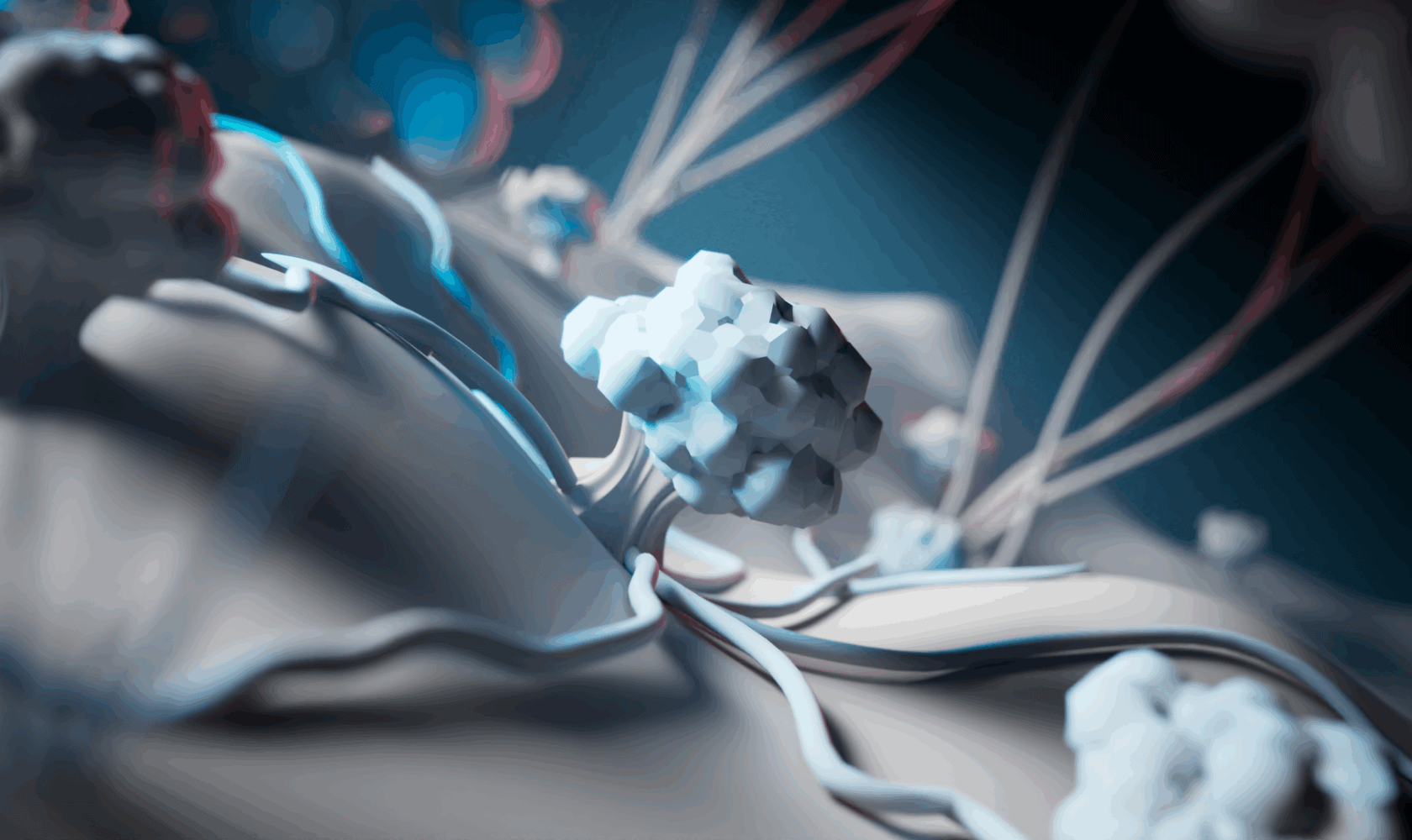In conversation with Laura Durham, 3D Artist at TMC
Following our first chat with Laura on how 3D breathes life into brand, product, and place, we sat down again to dig deeper into the craft. From the fine art of materials to the challenges that push her technical and creative boundaries – get to know the artist behind our 3D projects.
When we last spoke, you mentioned that materials are when a project truly comes alive. Can you share an example?
Absolutely – the animations we included in our recent medical showreel, such as cells splitting and cell surfaces, these came to life when crafting materials. Without materials these would just be grey scale models, and they wouldn’t have any life to them.
In a recent medical animation we created, the first version used flat, matte surfaces that absorbed light. They did the job to a point, but they didn’t have that spark. When we switched to a more metallic texture and let the light move across it as it animated, the whole thing felt elevated. It wasn’t just shinier – it made sense for the subject matter, which naturally had that metallic quality.
“Materials are the moment where a project truly comes alive.”
Are there certain materials that are more challenging to work with?
Definitely. Subsurface scattering – that’s how light passes through materials like skin or wax – can be tricky. If you get it wrong, it can look artificial, and it’s also slow to render.
At the other end of the scale, opaque metals tend to be easier, but it depends on the material, more complex finishes like brushed or anisotropic metals still need extra care.
But for any good 3D artist, the challenge also comes from bringing the mundane materials to life, for example, how do you make something very plastic look desirable?

Can you think of a recent creative challenge you’ve faced and how you solved it?
One project for a European medical society involved animating a neural network. I started in Maya, which is my main tool, but I couldn’t get it to work the way I wanted.
I ended up switching to Blender after finding a plugin that handled the effect perfectly. It’s a good example of why being adaptable with tools is so important.
“Being versatile in the software you use leads to better creative solutions.”
Speaking of tools — do different software packages work well together?
Maya is great for heavy lifting and complex files. Blender is brilliant for more playful motion work and procedural animation. They don’t always “talk” to each other seamlessly, but it’s possible to move assets between them. Recently, we’ve been using Blender’s geometry nodes – it’s much more user-friendly for procedural work.
For physics simulations, Houdini is quickly becoming a big industry standard and can produce amazing effects. Cinema 4D is also very good, which is quite similar to Blender interface and features wise. The other is Unreal Engine which is a game engine that offers real time rendering. We used it heavily when designing The Space – the ability to walk around the environment and change elements in real time was so useful.

How does 3D fit into wider studio projects?
A lot of my work is translated into other formats – brochures, websites, banners – both print and digital. I make sure the assets have transparent backgrounds and are rendered at the right resolution so our designers can use them flexibly. Transparency can be tricky with video, but it’s worth it for the creative freedom it gives the rest of the team when using it in different ways. It’s also important to consider resolution – we can create huge(!) files, which are ideal for large format graphics that are often many metres wide.
If you could ‘job safari’ with anyone in the TMC studio, who would it be?
I’d love to spend more time with our Head of Digital, Robin. There’s definitely crossover potential between 3D and interactive web experiences, and I think it could open up some exciting possibilities.
What advice would you give someone starting out in 3D?
Two things: always be curious and challenge yourself to stay observant. Tech changes all the time – you’ve got to want to keep learning. And observation is huge. The way light hits a surface, the detail in a texture… it all helps you make something believable.
“Stay curious and stay observant — those are the two most important skills for aspiring 3D artists.”
For tools, Blender is a brilliant starting point because it’s free. Some other well-known packages, like Houdini, offer non-commercial licences too. But alongside the technical skills, it’s important to nurture a love for art. The ability to understand composition, lighting, and storytelling in any media.
“I think just having a really good eye for art – you could be the most technical person, but unless you know how to place objects in a scene and how to light them and make it all come to life in a certain way – it won’t feel the same.”


Do your professional skills ever spill over into your personal life?
Absolutely. One of my goals this year was to do more oil painting – it’s great for understanding colour, value, form and composition, and that feeds back into my work. I also find myself analysing film and TV sequences, I’m crazy for the opening title sequences for the TV show Severance at the moment, I never skip them – I’m always looking for any telltale signs of a clever cut or technique in how it was made.
From fine-tuning metallic highlights to switching tools mid-project, Laura’s approach to 3D blends technical mastery with creative instinct — a balance that keeps her work evolving in exciting ways.
Ready to bring your vision to life in 3D?
Our studio team’s passion and precision are just the beginning. Whether you’re dreaming up immersive environments, dynamic product visuals, or captivating animations, TMC are here to make it real. Let’s collaborate to create something extraordinary.
Share this


